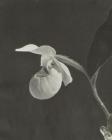38
Taken in 1913, "The Intruder" is Macnamara's most famous portrait. It was exhibited in Ottawa and England in 1913 and Montreal in 1914. This photograph of Jean Macnamara was published in The Amateur Photographer and Photographic News in August 1913 along with praise from critic Anthony Guest:"Credit is due to Mr. C. Macnamara for an extremely simple and suggestive scheme...that gives interest to an almost empty space, with the small head of a child as the point of interest near the centre. There are just the lightly suggested lines of the door...imagination fills up the blanks and a little domestic comedy is realised, if not seen".
40
Charles Macnamara used photography to explore and chronicle the natural world around him. He took thousands of photographs of flowers, animals, tracks, plants, rock formations and birds in addition to his landscape and pictorial images. Occasionally, he made technical notes regarding his photography:"Probably because it was growing in a rather shady place, the colors of this group were rather pale. The lips lacked the rich magenta-crimson of the best specimens. And although I used a Soft Gradation Pan plate, the negative came out too hard; the foliage is too dark and the flowers too light. I must try it again next year at an earlier date, give plenty of exposure and develop softly".
42
Charles exhibited his last pictorial works in 1917. By this time, pictorial photography seemed out of touch with the reality of war and a flu epidemic that was killing thousands of people around the world.In 1919, Charles Macnamara entered two prints of "The snow Flea" in an exhibit of prints by the members of the Photomicrographic Society at the Camera Club in London, England. In June 1919, Macnamara wrote a detailed description of his "Method of Multiple Gum-Printing" for The British Journal of Photography. In his concluding paragraph Macnamara wrote:
"Theoretically a gum-print should be completed in three printings, but this implies such a nice balance between coating, printing, and development that I suspect it does not often occur. Personally, I must confess that I have never reached a satisfactory conclusion in less than four printings, while the usual number is five or six, and some troublesome negatives have demanded as may as ten and twelve. In gum-printing it is much easier to give than to take away, and the best and safest method is to build up the picture very gradually."
44
By 1925, Macnamara was once again taking "snap-shots" for his own scrap books of memories. This photograph of the bridge over Waba creek was taken on an excursion to Pakenham hills with Armon Burwash.46
By 1934, Macnamara had moved from glass plate negatives to cellulose nitrate negatives. In the late 1930's he experimented with Dufaycolour, an early colour positive transparency. Macnamara used his L'Artistique lens to take this lovely image of his neighbour Genevieve Dupuis. He marked it "Best of this lot". Eva Murphy (a relative of Genevieve) was the girl in "The Laughing Girl" photograph that appeared in Photography & Focus magazine in 1910.48
As an amateur scientist, Macnamara was comfortable experimenting with various photographic chemicals such as M. Q. Developer. He mixed up a solution of this developer in 1925 and let it sit on the shelf for 10 years. He then compared the print quality of fresh developer against that of the 10 year old solution.50
"Jack Frost's idea of a landscape on Mars. The tree is growing beside one of the famous Martian canals and a strange bird is winging across the sky."Charles Macnamara compiled a scrapbook of Frost Patterns in the 1940's which entertained his young, great-niece Judith Cunningham. Macnamara was a member of the Photomicrographic Society of England and was most likely aware of Wilson Bentley's techniques to photograph snow crystals.
In April of 1940, Charles Macnamara photographed the solar eclipse by setting up an apparatus using a clothes horse with a large sheet of wrapping paper stretched over it. He took an envelope and cut a series of holes cut to focus the image of the sun. He recorded the following notes; "By the time these preparations were finished the eclipse was at its maximum and I photographed the crescentric images of the sun with the Linhof, measuring the exposure with the Sixtus and using an Ilford S.R. Panchromatic plate. Tried a red screen but got a better result with an Alpha. Actual length of the images was 4 inches as shown in the print." He was not satisfied with the results of his experiment but documented every part of it for later reference.






